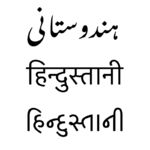Hindustani language facts for kids
Quick facts for kids Hindustani |
|
|---|---|
| Hindi-Urdu ہندوستانی • हिन्दुस्तानी |
|

The word Hindustani in Devanagari, Nastaliq and Kaithi scripts
|
|
| Native to | Pakistan, India. Various based on religion. |
| Native speakers | 240 million (date missing) Second language: 165 million (1999) Total: 490 million (2006) |
| Language family |
Indo-European
|
| Standard forms | |
| Dialects |
Khariboli (Dehlavi)
Kauravi
Dakhini?
|
| Writing system | Perso-Arabic (Urdu alphabet) Devanagari (Hindi and Urdu alphabets) Bharati Braille (Hindi and Urdu) Kaithi (historical) |
| Official status | |
| Official language in | |
| Regulated by | Central Hindi Directorate (Hindi, India), National Language Authority, (Urdu, Pakistan); National Council for Promotion of Urdu Language (Urdu, India) |
| Linguasphere | 59-AAF-qa to -qf |
Hindustani is a language spoken by many people, especially in India and Pakistan. It's like a big language family that includes two main forms: Hindi and Urdu. Even though Hindi and Urdu are written differently and have some different words, they are very similar in how their sentences are put together (their grammar).
Hindustani developed over many centuries. It became a common language for people from different backgrounds to communicate. It was especially important in the area around Delhi and Uttar Pradesh. Over time, this common language began to split into two main forms, Hindi and Urdu, influenced by different cultures and writing styles.
Contents
What is Hindustani?
Hindustani is often called a "fusion" language. This means it mixes elements from different languages. Its basic structure comes from Sanskrit, an ancient Indian language. However, it also has many words borrowed from Persian, Arabic, and even Turkish. This mix of words makes it rich and interesting.
Hindi and Urdu: Two Sides of the Same Coin
Hindi and Urdu are considered two registers (or styles) of the same Hindustani language. Imagine them as two different outfits for the same person.
How They Are Similar
- Grammar: The way sentences are built is almost identical. If you know the grammar of one, you'll understand the other.
- Spoken Language: When people speak everyday Hindustani, it's often hard to tell if they are speaking Hindi or Urdu. They can usually understand each other perfectly.
How They Are Different
- Writing Systems:
- Hindi is usually written using the Devanagari script. This script is also used for Sanskrit and other Indian languages.
- Urdu is usually written using a version of the Perso-Arabic script, which looks similar to the script used for Arabic and Persian.
- Vocabulary:
- Official Status:
- Hindi is one of the official languages of India.
- Urdu is the national language of Pakistan and also an official language in some parts of India.
Where is Hindustani Spoken?
Hindustani, in its Hindi and Urdu forms, is spoken by hundreds of millions of people around the world.
In India
In India, Hindi is the most widely spoken language. It is used in government, education, and media. Urdu is also spoken by many people, especially in certain states and cities.
In Pakistan
In Pakistan, Urdu is the national language. It plays a very important role in the country's identity and communication.
Around the World
Because many people from India and Pakistan have moved to other countries, Hindustani is also spoken in places like the United Kingdom, the United States, Canada, and parts of the Middle East.
History of Hindustani
The story of Hindustani begins many centuries ago. It grew out of older languages spoken in northern India. Over time, as different empires and cultures influenced the region, the language changed and grew.
The arrival of Persian-speaking rulers in India brought many Persian words into the local languages. This blend eventually led to the development of Hindustani. During the Mughal Empire, it became a very important language for communication and culture.
In the 19th century, during the time of British rule, the differences between Hindi and Urdu became more noticeable. This was partly due to different communities choosing to emphasize different aspects of the language.
Images for kids
See also
 In Spanish: Idioma indostánico para niños
In Spanish: Idioma indostánico para niños





